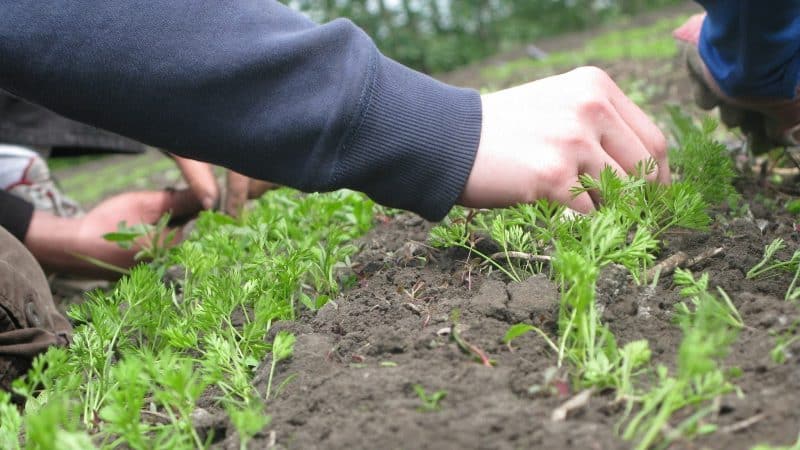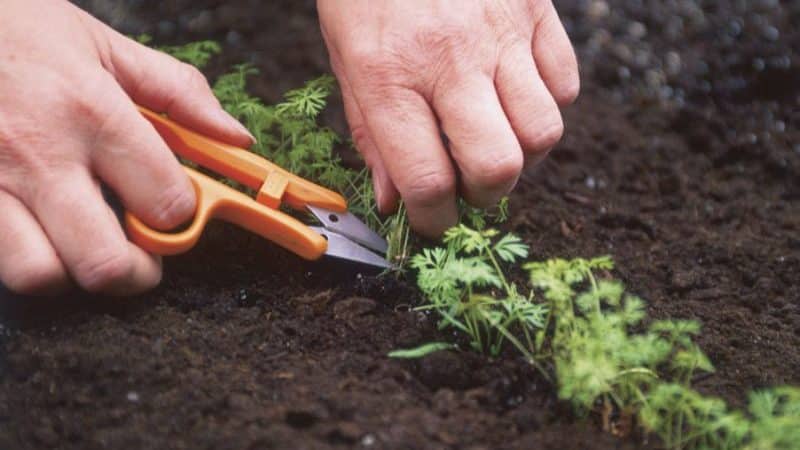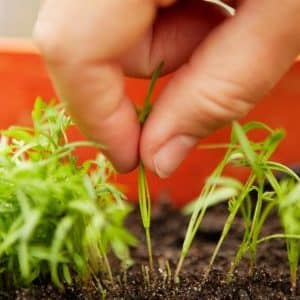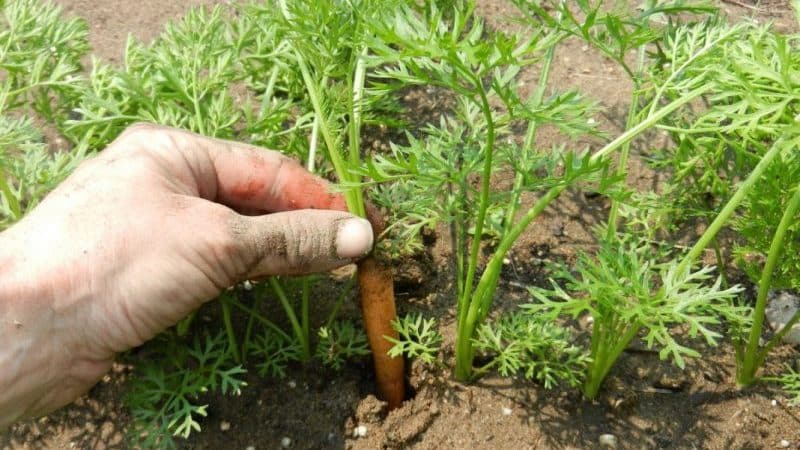Step-by-step instructions for beginning gardeners: how to properly thin carrots and why it is needed
Carrots are an unpretentious crop that is not too demanding on soil composition and climatic conditions. However, it is important to thin out plant seedlings on time, and this is a painstaking and tedious task.
Let's look at when and how to properly thin out carrots, why to do it, and how to sow a vegetable to avoid this procedure.
What is the purpose of thinning out seedlings?
This procedure creates optimal conditions for crop growth. Densely planted vegetables interfere with each other, their roots intertwine, forming root crops of irregular shape. Plants lack nutrition.
Pulling carrot beds is an important condition for obtaining a harvest of healthy, juicy root vegetables.

Is it possible to do without it?
When sowing in the traditional way, the seedlings will be thickened - it will not be possible to avoid thinning.
It will make caring for carrot beds easier by uniformly sowing one seed at a certain distance from each other or using special tapes with grains glued to them.
Timing of the procedure
Traditional growing method involves removing excess plants in 2 stages.
First stage
For the first time, carrots are thinned after the first 2 leaves have grown.
Advice! On the eve of the procedure, water the beds well. This will make it easier to remove excess plants without damaging neighboring ones.
At the first stage, a distance of 2-3 cm is left between plants.After the procedure, the beds are loosened, slightly compacting the soil next to the sprouts.
It is convenient to combine the first pulling with weeding. Removing weeds and loosening the soil will provide the tender shoots with optimal conditions for further development.
Second phase
The second time, the crops are thinned out after 2-3 weeks, when the tops have grown to 10 cm. In this case, the distance between the root crops is increased to 5–7 cm. When determining the exact interval, they are guided by the recommendations of the manufacturer of the variety or hybrid.
Attention! After thinning, a characteristic odor spreads from the removed plants, attracting a dangerous pest - carrot fly. Therefore, the sprouts are removed from the beds into a compost heap and covered with earth and sawdust.
Thinning should be moderate, otherwise it will negatively affect the quality of root crops and yield indicators.
Thinning technology

Carrots are pulled in different ways: with hands, tweezers or scissors.
Manually
Excess sprouts are removed manually by carefully grasping them with two fingers. If the soil has been well moistened beforehand, the plant can be easily pulled out along with the root.
Important! When pulling, pull the sprout straight up, trying not to tilt it to the side. Otherwise, there is a high risk of damage to the roots of neighboring plants. Damaged sprouts form additional lateral roots, and the vegetable grows horned or twisted.
The procedure is carried out in clear weather so that all plants are clearly visible.
Tweezers
Ordinary tweezers are a reliable assistant in this procedure. It is especially convenient to use it at the first stage, when the sprouts are still very small and it is not easy to grasp them with your fingers.
First, the soil is thoroughly moistened, and after a while the procedure begins.Using a tool, grab the plant stem as close to the soil surface as possible and with a sharp movement pull the stem up.
Scissors
This is a quick way to remove small and weakly developed plants. The essence of the method is as follows: using sharply sharpened scissors, cut off the above-ground parts of excess sprouts. Do not touch the roots: after a while they will dry out on their own.
Thinning in a greenhouse
Cultivating early carrots in greenhouse conditions allows you to harvest the first harvest at the beginning of summer.
Greenhouse care landings similar to caring for beds in open ground. Plants are thinned and weeded in 2 stages, removing weak and diseased specimens. Before the procedure, the soil is moistened, and then loosened and compacted.
Replanting carrots removed during thinning
If there is a place on the site free from crops, the pulled out sprouts are often replanted. After this, carrots do not take root well, so, unlike beets, they are not grown in seedlings.
Advice! Removed shoots are replanted only after the first stage of thinning, while the plants are very small. At the second stage, replanting is not recommended - the carrots will hurt for a long time and will grow small and unsightly.
In the selected area, use a pencil or a straight stick to mark holes and place the seedlings in them. The soil around the plants is compacted and well watered. With proper care, the sprouts will give a significant increase in the harvest.
Planting methods without thinning
Using simple techniques will eliminate the need for pulling carrot beds or significantly simplify this procedure:
- Mixing seeds with bulk material. The grains are small, so sowing them evenly is not an easy task.It will be simplified by adding dry sand, fine peat chips, dried coffee grounds or other suitable material.
- Mixing radish and carrot seeds. Early ripening varieties The radishes will ripen before the carrot sprouts appear. So, two crops are harvested from one bed.
- Mixing seeds with paste. The cooled liquid paste along with the grains is poured into the grooves. To do this, it is convenient to use an old kettle with a spout.
- Sowing pelleted seeds. They are much larger than usual, so it is easier to plant them evenly.
- Sowing grains glued to tape. To do this, seeds tested for germination are attached with a paste to strips of toilet paper or ready-made tapes are purchased.
With any method, special attention is paid to the quality of planting material. Seeds must be fresh and only from trusted manufacturers.
Advice from experienced summer residents

Recommendations from experienced gardeners will help you grow an enviable harvest of juicy, crispy carrots:
- the culture loves fertile, light and loose soil;
- weeds and stones lead to deformation of root crops during growth;
- fertilizing with fresh manure leads to distortion and branching of vegetables (it is better if the manure was applied 1-2 years ago);
- with a lack of moisture, root vegetables form lateral roots, and this has a bad effect on the taste and appearance of vegetables;
- the site is prepared in the fall, if necessary, deoxidizing the soil with lime or dolomite flour and introducing phosphorus and potassium fertilizers;
- in the spring, the soil in the garden bed is loosened, carefully breaking up clods of earth and selecting stones;
- monitor the illumination of crops;
- carrots grow well where tomatoes, legumes, cabbage, potatoes, and cucumbers were previously planted.
Following these recommendations will eliminate problems when growing crops and will produce smooth, healthy root crops.
Reviews
Each summer resident has his own way of thinning carrot beds and his own observations regarding this procedure.
Natalya, Nizhny Novgorod: «Every year I sow carrots in the traditional way and then thin them out in 2-3 stages. I think that pulling gives excellent results. The result is larger carrots that are about the same size.”
Valentina, s. Lugovoe: “I had experience sticking seeds on toilet paper. Unfortunately, unsuccessful. Nothing came up at all. Now I mix the seeds with dried coffee and plant them. The result is excellent, there is almost no need to pull.”
Alina, s. Red: “I usually thin out carrots in 3 stages, since it’s difficult to determine which carrots to keep the first time. The first thinning, of course, is the main one in terms of the number of plants removed. In June I finish sowing in those places where the carrots have not sprouted.”
Conclusion
Thinning carrot beds is an important stage of crop care, necessary for the normal growth and development of root crops. Thickened plantings lead to the formation of small, twisted carrots. Sowing on a tape will help you avoid this tedious procedure.